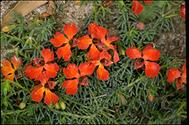In Flower This Week
A weekly news sheet prepared by a Gardens' volunteer.
Numbers before each plant refer to temporary IFTW labels in the gardens.
Numbers in square brackets [ ] refer to garden bed Sections. Plants in flower are in bold type.
View past issues of 'In Flower This Week'.
2 April 2014
Lechenaultia formosa click for larger image |
We will walk part of the Main Path today, starting amongst the eye-catching pots at the Visitor Information Centre (VIC).
- Notice at the front of the VIC a pot of Hemiandra pungens [Section 221], commonly known as Snakebush, a trailing plant with bright green leaves and mauve tubular flowers. It is endemic to south-western Western Australia where it grows on rocky outcrops.
- Also near the door is a pot of Lechenaultia formosa [Section 221] which is a small attractive plant with close grey-green foliage and bright red flowers with orange centres.
- Further along on your right is Banksia spinulosa ‘Birthday Candles’ [Section 174], a low shrub with needle-like foliage and yellow candle-like flower heads. ‘Birthday Candles’ is a dwarf cultivar of Banksia spinulosa var. spinulosa developed by Bill Molyneux of Austraflora Nurseries in Montrose, Victoria.
- Banksia heliantha [Section 174], which used to be known as Oak-leaved Dryandra before the reclassification of all dryandras to banksias, is in a pot on your right. It has stiff spiky foliage and a magnificent green immature flower head erupting from a rusty red base.
- Also on your right is Spyridium burragorang [Section 174], a long-flowering medium-sized shrub with unusual white bracts surrounding a central cluster of flowers. It is confined to the Lake Burragorang district of New South Wales and it is considered rare in the wild.
- Cross the bridge and continue around the side of the café to see on your right Correa ‘Summer Belle’ [Section 240], which is a long-flowering small shrub with long pink bell flowers with protruding stamens.
- On your left is Epacris longiflora ‘Nectar Pink’ [Section 131], which is a very floriferous small shrub covered in slender pink bell flowers with white tips.
- Callistemon citrinus ‘Splendens’ [Section 240] is a small tree on your right with weeping foliage and bright red brush-like flowers beloved by spinebills and wattlebirds.
- Walk uphill now past the Monocotyledon section to see on your left a large bush with fine heath-like foliage and tall orange flower heads. This is Banksia ericifolia subsp. ericifolia [Section 30] or Heath-leaved Banksia.
- Further along on your right is another banksia in bloom, Banksia spinulosa ‘Honeypots’ [Section 9], a small bush with fine-toothed foliage and long orange flower heads.
- Also on your right is Banksia integrifolia subsp. integrifolia [Section 9], a large vigorous mounding groundcover with dark green leaves with silver backs and plenty of short greenish-yellow flower heads.
- On your right is Buckinghamia celsissima [Section 27] or Ivory Curl, which is a small tree with fragrant dense terminal clusters of cylindrical ivory flower spikes. These trees grow naturally only in the wet tropics rainforest areas of north-eastern Queensland.
- Cross the road to see on your left Hakea cycloptera [Section 24], or Elm-seed Hakea, with incredibly prickly foliage and dusty pink flowers at the base of the leaves. It is native to South Australia.
- Banksia marginata ‘Cape Patterson Dwarf’ [Section 26] on the right is an unusual small version of our common local Banksia marginata. It has short lime-green flower heads and dark green silver-backed foliage.
- On your right is a small tree covered in short green cones with grey-tipped flowers and a velvety brown “nose” protruding from the top of the flower head. This lovely tree is Banksia conferta subsp. penicillata [Section 26] or Newnes Plateau Banksia.
Rosalind Walcott
![Director of National Parks [logo]](../../../../images/dnp_90px.gif)







